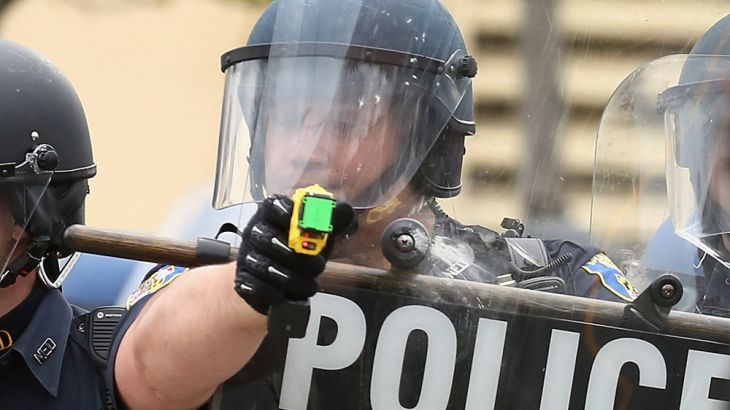
The Taser Cases
As US police increase the use of tasers, we find out how the “less lethal” weapons have been linked to injury and death.
With increased scrutiny of police shootings around the US, many police departments are embracing a “less lethal” approach by acquiring more tasers.
I called 911 to help them not to kill him. Last thing I said to him was 'Chase, 911 is here. And they're gonna help you.' And they killed him.
Taser International, the main manufacturer of the electroshock devices, has sold them to more than 17,000 law enforcement agencies in the US by promoting them as safe and effective.
Keep reading
list of 4 itemsFormer US police officer sentenced in killing of Black man Elijah McClain
US paramedics found guilty in 2019 death of Black man Elijah McClain
Angela Davis: ‘Palestine is a moral litmus test for the world’
They are meant to immobilise a person by sending shocks of electricity through projectile darts or cause pain by directly stunning a person’s body.
But in the past decade, more than 500 people across the US have died after being shocked with a police taser, and many more have been seriously injured.
Corey McGinnis is one of them; he was tasered in the chest by police and died.
McGinnis was playing basketball at a park in Ohio in 2012 when a group of men allegedly started a fight. Someone heard the sound of gunshots and called the police.
An officer at the scene said he told McGinnis to get on the ground, but he remained standing with his hands balled into fists. The officer perceived him as a threat and fired his taser.
Dr Douglas Zipes is a cardiologist and professor who has given lectures on the impact of taser shocks. He has also been an expert for plaintiffs in taser-related death cases, including the McGinnis case.
Looking at the McGinnis autopsy, Zipes says: “One [of the burns produced by the taser probes] is virtually directly over the heart. The other is in the upper abdomen. And there is no question that this vector, that is the electricity travelling between these two taser probes is sufficient to capture the heartbeat, speed it up, make it go into ventricular fibrillation and cause cardiac arrest and sudden death.
“From my standpoint, to a reasonable degree of medical probability or medical certainty, this is a taser-induced cardiac arrest and subsequent death.”
But Taser International Materials says that when used properly the devices are safe and effective and have saved thousands of lives. However, it warns against excessive use.
“I don’t advocate that we eliminate tasers. I actually think if we can train people properly and research tasers carefully, they can be a valuable asset to the law enforcement arsenal. But there are many communities that will not spend the money to train people properly, and that’s when we find instances of excessive force,” says Al Gerhardstein, a civil rights attorney.
Tasers are routinely touted by the police as an alternative to deadly force, but how non-lethal are electroshock weapons?
Fault Lines examines the serious injuries and deaths that have been linked to police taser use and how potential risks may have been obscured.
![Lisa and Yolanda McGinnis, the niece and sister of Corey McGinnis, who died after being shocked with a taser by police in 2012 [Josh Rushing/Al Jazeera]](/wp-content/uploads/2016/10/7522c66745e54ff3b23090464b4de442_18.jpeg)